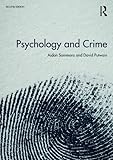Psychology and crime / Aidan Sammons and David Putwain
Material type: TextLanguage: English Series: Routledge modular psychologyPublication details: New York : Routledge, 2002.Edition: 1stDescription: xv, 200 p.: illustrations ; 21 cmISBN:
TextLanguage: English Series: Routledge modular psychologyPublication details: New York : Routledge, 2002.Edition: 1stDescription: xv, 200 p.: illustrations ; 21 cmISBN: - 9780815369523
- 23 364.3 SAM
| Item type | Current library | Collection | Call number | Status | Date due | Barcode |
|---|---|---|---|---|---|---|
 General Books
General Books
|
CUTN Central Library Philosophy & psychology | Non-fiction | 364.3 SAM (Browse shelf(Opens below)) | Available | 43680 |
HB
1 Introduction; The origins of criminological psychology; Applying psychological principles to crime; Forensic psychology; Aims, organisation and content of this book; 2 Defining and measuring crime; What is a crime? What is a criminal?; The legalistic approach; The deviance approach; Variables associated with criminality; Age; Gender; Socio-economic status; Race and ethnicity; Measuring crime; Official crime statistics; Victimisation surveys; Offender surveys; Trends in crime; Victimisation; Property crime; Violent crime. Intimate violence and sexual crimeRepeat victimisation; Effects of victimisation; Fear of crime; Chapter summary; Further reading; 3 Biologically oriented explanations of offending; Biological differences between offenders and non-offenders; Low heart rate; Brain structure and functioning; Brain chemistry; Influences on the nervous system; Genetics; Genetic influences and evolution; Environmental toxins: lead pollution; Traumatic brain injury; Adverse childhood experiences; Biopsychology and offending: general considerations; Chapter summary; Further reading. 4 Psychologically oriented explanations of offendingPsychodynamic theories; Attachment, delinquency and offending; Eysenck's personality theory; Psychopathy; Moral development; Social cognition; Cognitive and emotional deficits; Moral disengagement; Rational choice theory; Chapter summary; Further reading; 5 Socially oriented explanations of offending; Social learning theory; The influence of TV, films and videogames; Labelling and self-fulfilling prophecy; Social identity theory; Poverty; Neighbourhood influences; Chapter summary; Further reading; 6 Psychology and police investigations. The processing of forensic evidencePolice interviews; The standard interview procedure; Cognitive interviewing; Interrogation of suspects; False confessions; Ethical interviewing and the PEACE model; Offender profiling; Types of profiling; Crime scene analysis; Clinical profiling; Geographical profiling; Investigative psychology; Does profiling work?; Chapter summary; Further reading; 7 Witness testimony; Cognitive processes and witness testimony; Weapon focus; Contamination by post-event information; Emotional arousal; Child witnesses; Identity parades (lineups); Facial composites. Chapter summaryFurther reading; 8 Courtroom processes; Trial procedures; Juries; Jury size and composition; Jury deliberation; Influences on jury decisions; Persuasion by trial lawyers; The Yale Model; Systematic versus heuristic processing; Storytelling in court; Courtroom evidence; Pretrial publicity; Defendant characteristics; Attractiveness; Gender; Race/ethnicity; Death penalty decisions; Issues arising from mock jury research; Chapter summary; Further reading; 9 Judicial responses to offending; Imprisonment; Does prison work?; Retribution; Incapacitation; Deterrence; Reform.
Analysing psychological theories about the offender, this work considers society's response to crime, including the role of the police and the courts, and finally examines methods of crime prevention.


There are no comments on this title.